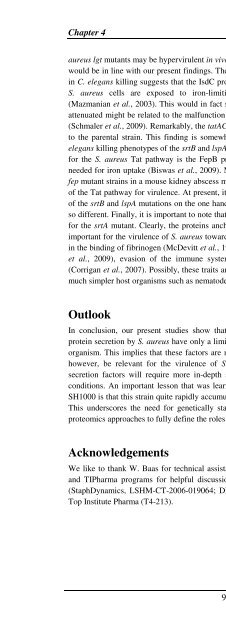The Staphylococcus aureus secretome - TI Pharma
The Staphylococcus aureus secretome - TI Pharma
The Staphylococcus aureus secretome - TI Pharma
Create successful ePaper yourself
Turn your PDF publications into a flip-book with our unique Google optimized e-Paper software.
Chapter 4<br />
<strong>aureus</strong> lgt mutants may be hypervirulent in vivo (Stoll et al., 2005;Bubeck et al., 2006), which<br />
would be in line with our present findings. <strong>The</strong> observation that the srtB mutant is attenuated<br />
in C. elegans killing suggests that the IsdC protein is required for C. elegans killing and that<br />
S. <strong>aureus</strong> cells are exposed to iron-limiting conditions during C. elegans infection<br />
(Mazmanian et al., 2003). This would in fact suggest that the reason why the lspA mutant is<br />
attenuated might be related to the malfunction of certain lipoproteins involved in iron uptake<br />
(Schmaler et al., 2009). Remarkably, the tatAC mutant showed a higher killing rate compared<br />
to the parental strain. This finding is somewhat difficult to reconcile with the observed C.<br />
elegans killing phenotypes of the srtB and lspA mutants, because the only confirmed substrate<br />
for the S. <strong>aureus</strong> Tat pathway is the FepB protein, which is an iron-dependent peroxidase<br />
needed for iron uptake (Biswas et al., 2009). Moreover, the bacterial loads of tatAC and tatfep<br />
mutant strains in a mouse kidney abscess model were decreased, suggesting a requirement<br />
of the Tat pathway for virulence. At present, it remains unfortunately unclear why the effects<br />
of the srtB and lspA mutations on the one hand and the tatAC mutation on the other hand are<br />
so different. Finally, it is important to note that no C. elegans killing phenotype was observed<br />
for the srtA mutant. Clearly, the proteins anchored by sortase A to the cell surface are very<br />
important for the virulence of S. <strong>aureus</strong> towards mammals as they are, for example, involved<br />
in the binding of fibrinogen (McDevitt et al., 1997), binding to nasal epithelial cells (Corrigan<br />
et al., 2009), evasion of the immune system (Sasso et al., 1991) or biofilm formation<br />
(Corrigan et al., 2007). Possibly, these traits are less relevant for S. <strong>aureus</strong> virulence towards<br />
much simpler host organisms such as nematodes.<br />
Outlook<br />
In conclusion, our present studies show that many of the non-essential determinants for<br />
protein secretion by S. <strong>aureus</strong> have only a limited impact on general protein secretion by this<br />
organism. This implies that these factors are mainly required for special purposes that may,<br />
however, be relevant for the virulence of S. <strong>aureus</strong>. Defining the precise roles of such<br />
secretion factors will require more in-depth studies, especially under infection mimicking<br />
conditions. An important lesson that was learned from the studies with the S. <strong>aureus</strong> strain<br />
SH1000 is that this strain quite rapidly accumulates mutations causing an agr-like phenotype.<br />
This underscores the need for genetically stable model strains for molecular genetics and<br />
proteomics approaches to fully define the roles of the <strong>secretome</strong> in staphylococcal virulence.<br />
Acknowledgements<br />
We like to thank W. Baas for technical assistance, and colleagues from the StaphDynamics<br />
and <strong>TI</strong><strong>Pharma</strong> programs for helpful discussions. Financial support was provided by CEU<br />
(StaphDynamics, LSHM-CT-2006-019064; DFG (GK212/3-00, SFB/TR34, FOR 585), and<br />
Top Institute <strong>Pharma</strong> (T4-213).<br />
90













